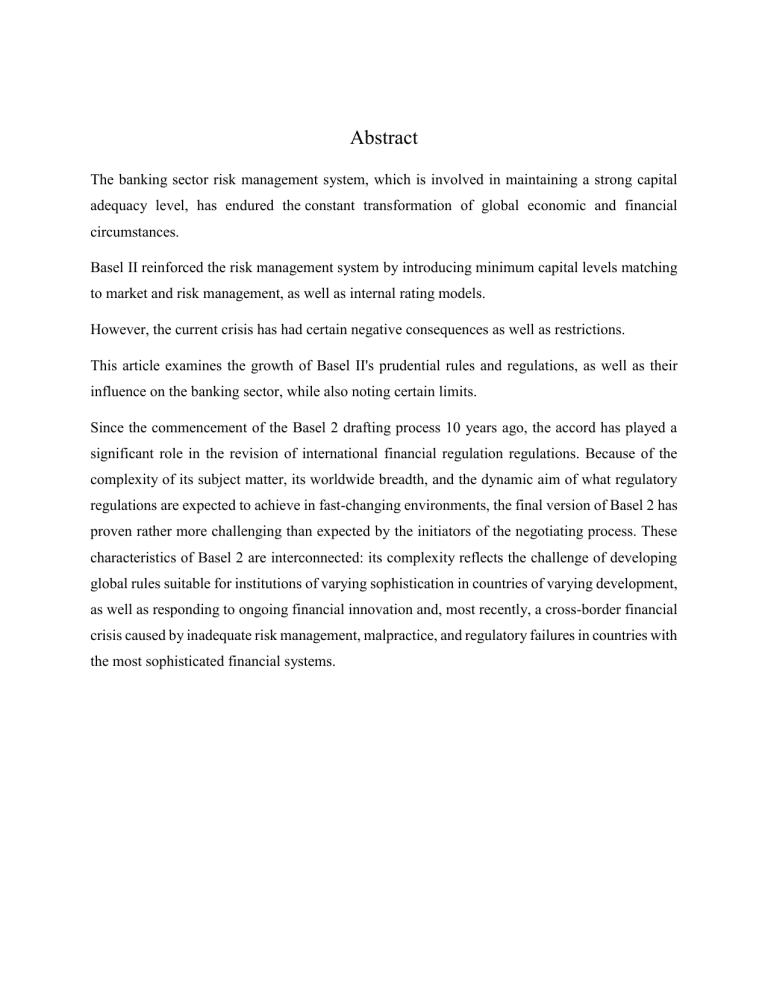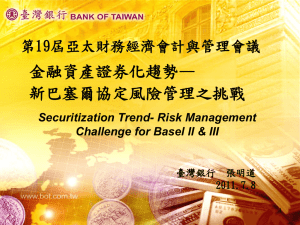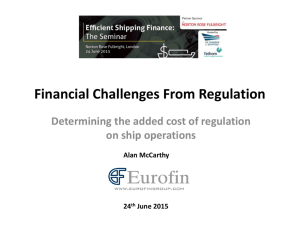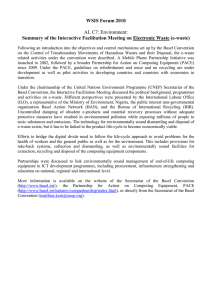
Abstract The banking sector risk management system, which is involved in maintaining a strong capital adequacy level, has endured the constant transformation of global economic and financial circumstances. Basel II reinforced the risk management system by introducing minimum capital levels matching to market and risk management, as well as internal rating models. However, the current crisis has had certain negative consequences as well as restrictions. This article examines the growth of Basel II's prudential rules and regulations, as well as their influence on the banking sector, while also noting certain limits. Since the commencement of the Basel 2 drafting process 10 years ago, the accord has played a significant role in the revision of international financial regulation regulations. Because of the complexity of its subject matter, its worldwide breadth, and the dynamic aim of what regulatory regulations are expected to achieve in fast-changing environments, the final version of Basel 2 has proven rather more challenging than expected by the initiators of the negotiating process. These characteristics of Basel 2 are interconnected: its complexity reflects the challenge of developing global rules suitable for institutions of varying sophistication in countries of varying development, as well as responding to ongoing financial innovation and, most recently, a cross-border financial crisis caused by inadequate risk management, malpractice, and regulatory failures in countries with the most sophisticated financial systems. 1. What is a Financial Crisis? By definition, a financial crisis occurs when the value of assets’ prices sharply declines, enterprises and consumers are incapable to meet their financial obligations, and the liquidity shortage the financial institutions encounter. Usually, a financial crisis occurs due to a panic or back run; in which depositors and investors either sell their assets or withdraw their money from saving accounts. This is because they are afraid that the value of the assets will deteriorate if the money is kept in the financial institutions. A financial crisis might be concentrated only in financial institutions or expand to affect an economy of a region or economies worldwide. (Klenton, 2021) Examples of financial crises include Stock market collapse, credit crisis, the eruption of financial bubbles, and currency crisis. Financial crises examples: Since the occurrence of currency exchange, financial crises have had a special link with this exchange. For more than 350 years ago, financial crises have had existed; either running smoothly or shocking up the whole economy. In the following, a list of well-known financial crises will be briefly displayed. (Klenton, 2021) i. Tulip Mania (1637): There were a lot of arguments about whether this crisis would be considered a financial crisis or not since it did not have a great effect on the Dutch economy. However, historians changed their point of view since this Mania correlated with a highly infectious outbreak, which had a major impact on the economy. Taking into consideration this effect, it was difficult to decide whether over-speculation or the pandemic triggered the crisis. (Cornford, 2009) ii. Credit Crisis of 1772: After a period of significant credit expansions, by March/ April of 1772, this crisis arose. To avoid repaying his obligations, Alexander Fordyce, an investor in a large bank, fled to France when he faced shorting shares of the East India Company which resulted in a massive loss. Back then, panic spread widely that resulted in bankruptcy or investors and depositors’ impedimental payments. Correspondingly, Europe was affected by the crisis. Historians believe that the cause of the Boston Tea Party – the unpopular tax law implemented in the 13 colonies – is associated with this crisis. As a result, it resulted in the American Revolution in 1775. iii. Stock Crash of 1929: On October 24th, 1929, after frantic speculations and bulk borrowing to purchase shares, the stock market collapsed. As a result of this crash, the Great Depression was born. In about a decade, the Great Depression was widely spread worldwide. A huge oversupply of money in the market was one of the main sources of this collapse. As a result, it led to a decrease in prices. Thus, this market crash enhanced new regulations and marketcontrolling rules were implemented. (Klenton, 2021) iv. OPEC Oil Crisis in 1973: In October 1973, OPEC members imposed an oil boycott on nations that backed Israel during the Yom Kippur War. The price per barrel of oil had soared from $3 to $12 at the end of the embargo. Considering modern economies rely on oil, increasing costs and uncertainty contributed to the market collapse of 1973-1974, when, between January 1973 and December 1974, a decline of 45% of the Dow Jones Industrial Average’s value v. Asian Crisis of 1997-1998: With the collapse of the Thai Baht in July 1997, the crisis was triggered. The Thai government was obliged to abandon the US dollar peg and allow the Baht to float due to a lack of foreign currency. As a result, there was a massive devaluation across the whole of East Asia, including Japan, and a vast increase in debt-to-GDP ratios. The crisis resulted in tighter banking laws and monitoring. vi. The 2007-2008 Global Financial Crisis: This financial crisis has shown that it was the worst economic crisis, much like the 1929 Stock Market collapse. After Lehman Brothers, an investment bank, declared insolvency in September 2008. Hence, this step had transformed into a primary crisis with mortgage loans crisis in 2007. Huge bailouts and other measures aimed at limiting the damage's spread failed, and the global economy suffered a downturn. (Klenton, 2021) 2. Financial Crisis in 2008: Since the Great Depression of 1929, the financial crisis of 2008 has been the biggest economic catastrophe. (Treasury, 2012) Although the Federal Reserve and the US Department of Treasury had exerted a lot of effort to stop this crisis from happening, it still arose. The crisis ushered in the Great Recession, during which real estate prices dropped even more than they had during the Great Depression. Unemployment was still above 9% two years after the recession hit. This does not include discouraged employees who had given up looking for work. (Unemployment in September 2011, 2011) In a century, this worldwide financial crisis was the most destructive to the financial system. In September 2008, Lehman Brothers, one of the world's largest financial corporations, went bankrupt in a matter of a few weeks; the value of Britain's largest corporations was washed out in a single day, and there were even reports of cash machines facing bankruptcy. (HistoryExtra, 2021) a) When did it begin? Lehman Brothers (a Wall Street investment bank) declared bankruptcy on September 15, 2008. This is generally acknowledged as the official start of the economic crisis. Then, according to President George W. Bush, there would be no bailout. (HistoryExtra, 2021) b) Causes of the Crisis: The 2008 global financial crisis has ancient origins, but it was not until September 2008 that the true impact of the crisis became obvious to the rest of the world. For the first time in decades, household prices started to fall in 2006. Realtors were optimistic at first. They believed that the overheated real estate market will cool down and become more manageable. Some credited the situation to the Community Reinvestment Act, which incentivized banks to invest in subprime regions. The Federal Reserve discovered that it did not increase risky lending in several examinations. Others placed the entire catastrophe on Fannie Mae and Freddie Mac. They believe that suspending or privatizing the two agencies is the best solution. The real estate market would collapse if they were shut down because they insure the most of mortgages. According to Scott Newton, University of Cardiff senior lecturer of contemporary British and global history, the principal cause was speculation activities in financial markets, with such a particular focus on property transactions - particularly in the United States and Western Europe and the supply of inexpensive credit. "A massive sum of funds was borrowed to finance what appeared to be a one-way bet on house price rises. Nevertheless, the boom was short-lived since, starting around 2005, the gap between income and debt began to widen. This was driven by increasing fuel prices on worldwide markets, which resulted in a rise in global inflation. "Borrowers were pressured as a result of this trend, with many failing to repay their loans. Property prices have begun to decline, causing the value of assets owned by numerous financial institutions to plunge. The banking institutions of the United States and the United Kingdom were on the brink of failure and had to be rescued by government intervention. According to Martin Daunton, retired professor of economic history at the University of Cambridge, "excessive financial liberalization from the late twentieth century, supported by a lessening in regulation, was anchored by the trust that markets are efficient." (HistoryExtra, 2021) c) Where did the crisis start? "The crash primarily impacted the United States banking and financial sector, with contagion throughout Europe," Daunton explained. "Another crisis emerged here, this time including sovereign debt, as a consequence of the Eurozone’s defective design, which allowed nations like Greece to borrow on comparable terms to Germany in the expectation that the Eurozone would bail out debtors." "When the crisis struck, the European Central Bank refused to reschedule or mutualize debt, instead offering a bailout plan - on the condition that the afflicted countries implement austerity measures." (HistoryExtra, 2021) d) Was the 2008 financial crisis predicted? Several economists claim to have foreseen the 2008 financial disaster. In 2003, Ann Pettifor, a reviser of The Real World Economic Outlook and an English writer and economist, forecasted an Anglo-American debt stagnation for the crisis. Then there was The Coming First World Debt Crisis (2006). However, as Newton notes, "The crash surprised economists and observers since most of them were brought up to believe that the free market system is the only viable economic model. The dissolution of the Soviet Union and China's embrace of capitalism, as well as financial innovations, reinforced this conviction, leading to the mistaken belief that the system was unassailable." (HistoryExtra, 2021) e) Actions adopted by policymakers to fix the 2008 financial crisis: According to Newton, policymakers were initially positive. "Governments did not utilize public spending cuts as a means of debt reduction, applying the guidelines of famous interwar economist John Maynard Keynes. Instead, there were modest national relations, which were intended to keep economic activity and employment going while also replenishing bank and corporate balance sheets through development. These packages were complemented by a significant increase in the IMF's resources, which were designed to help countries with big deficits and offset pressure on them to cut back, which may lead to a trade downturn. Three initiatives are taken together prevented a severe worldwide production and employment decline." (HistoryExtra, 2021) f) The Impact of the 2008 Financial Crisis: In the short term, a massive bailout - the government injecting billions into failing banks prevented the financial system's total collapse. The long-term repercussions of the catastrophe were enormous: lower wages, repression, and serious political unrest. We are still facing the consequences ten years later. There was plenty of hardship in the aftermath of the 2008 financial crisis—millions of Americans lost their homes to mortgage bankruptcies, and the unemployment rate had increased to nearly 10% by the summer of 2010—but nothing on the same scale. The unemployment rate has now dropped to just 3.9 percent. (HistoryExtra, 2021) Basel 2: The Basel II Accord was established in response to significant losses in worldwide markets since 1992, which were blamed on weak risk management procedures. The Basel II Accord requires financial firms to adopt standardized credit, market risk, and operational risk measurements. Different levels of compliance, on the other hand, allow financial institutions to employ advanced risk management strategies to free up resources for investment. (Chen & Mansa, 2020) Basel II is a set of international banking regulations proposed by the Basel Committee on Bank Supervision that leveled the international regulatory field by establishing uniform rules for minimum capital requirements established under Basel 1, the first international regulatory accord, and providing the framework for regulatory review, as well as setting disclosure requirements for assessing banks' financial strength. The primary distinction between Basel 2 and Basel 1 is that Basel 2 considers credit risk of assets held by financial institutions when calculating regulatory capital ratios. (Chen & Mansa, 2020) Basel 2 is a second international banking regulation agreement founded on 3 key pillars: minimal capital requirements, regulatory supervision, and market discipline. The most key component of Basel 2 is the requirement for banks to maintain minimum capital ratios of capital requirements over risk-weighted assets. Because banking policies varied greatly between nations before the implementation of the Basel agreements, a uniform framework of Basel 1 and, later, Basel 2 helped governments ease concerns about regulatory competition and vastly diverse national capital needs. (Chen & Mansa, 2020) Basel II is founded on three pillars: Pillar 1: Minimum Capital Requirement: The first pillar is concerned with the continuing maintenance of regulatory capital needed to protect a bank against the three basic sources of risk that it faces: credit risk, operational risk, and market risk. Credit risk can be calculated in three methods, each with a different level of sophistication: Standardized Approach, Foundation Internal Rating-Based (IRB) Approach, and Advanced IRB Approach. (Cornford, 2009) There are three different approaches to operational risk: 1) The Fundamental Indicator Approach (BIA) 2) Methodology Standardization (STA) 3) Internal Measurement Approach (IMA), a more sophisticated version of which is the Advanced Measurement Approach (AMA) 4) For Market Risk, Basel II adopts both Regulated and Internal techniques. Value at Risk is the preferable method (VaR). As the banking industry implements the Basel II recommendations, it switches from defined standards to more precise and specialized regulations suited to each risk category by each bank. Banks that build their own bespoke risk measurement systems may be rewarded with possibly lower risk capital requirements. Pillar 2: Regulatory Supervision: This is a regulatory response to the first pillar, facilitating improved 'means' to regulators that were previously accessible. In addition, it displays structures for dealing with Pension Risk, Systemic Risk, Concentration Risk, Strategic Risk, Reputational Risk, Liquidity Risk, and Legal Risk, which are all bundled under the overarching framework Residual Risk in the agreement. Pillar 3: Market Behavior: This pillar plans to improve market discipline by providing a set of disclosure rules that enable market players to evaluate crucial pieces of information on the scope of application, capital, risk exposures, risk assessment systems, and hence the institution's capital adequacy. Market discipline supplements regulation through promoting the evaluation of the bank by others (including investors, analysts, customers, other banks, and rating agencies), resulting in strong corporate governance. The market is effectively informed about a bank's exposure to particular risks by providing disclosures based on a consistent framework, and a clear and intelligible disclosure framework is supplied, which promotes consistency. Except for qualitative disclosures that provide an overview of the basic risk management objectives and policies, which can be presented annually, these disclosures must be submitted yearly. Institutions must also develop a clear policy outlining what will be revealed and the restrictions that will be in place, as well as the validity and frequency of these disclosures. In general, the disclosures under Pillar 3 relate to the banking group's highest consolidated level, to which the Basel II framework applies. In addition, it contains various disclosure standards for banks' risk exposures, risk assessment methodologies, and capital adequacy, which are all valuable to financial statement users. Under Basel II's Formation Theory, entities from OECD nations are no longer preferred above those from non-OECD countries. Banks and non-financial firms are now distinguished by their credit ratings, and unrated nonfinancial debtors are given a weight of 100 percent (corresponding to a capital requirement of 8 percent). Under the Internal Ratings-Based method, banks utilize their rating systems to quantify some or all of the drivers of credit risk, namely the chance of default, loss given default, exposure at default, and remaining maturity of the exposure, subject to regulatory permission. In the Foundation version of the Internal Ratings-Based Approach, banks compute the likelihood of default using their ratings but rely on their supervisors for assessments of the other credit risk factors. Banks estimate their estimates of all credit risk drivers under the advanced version of the Internal Ratings-Based Approach. (Cornford, 2009) However, because of the lengthy structure of the Basel II discussions, the Basel Committee's concerns were not reflected in new laws restraining the increasingly unsound structures associated with the 'originate-to-distribute' model of securitization early in the new millennium. Debts created or originated by one institution are aggregated and transferred to a special purpose entity under the 'originate-to-distribute' paradigm. The assets in this vehicle serve as collateral for securities issued to investors, frequently in tranches with varying yields based on the degree of risk. (Cornford, 2009) Basel II, an agreement on the minimum regulatory capital and risk management of banks that overlaps with many of the topics addressed by the international regulatory reform process, plays a key role in this agenda. The Basel Committee on Banking Supervision (BCBS) began drafting Basel II a couple of years ago, and its implementation is underway in several countries. However, the encounter of the recession has led many to conclude that important parts of the agreement, particularly those concerning the scale and quality of banks' overall capital levels and the allocation of capital to exposures whose riskiness was inadequately assessed before the crisis, require rethinking and revision. (Cornford, 2009) The Basel II committee and banks misjudged both the risk of asset losses and their exposure to the failure of others, which contributed to the financial crisis. Basel II bank rules promoted this obliviousness by requiring just the flimsiest of capital buffers for structured debt such as securitized mortgages. When it became evident that losses may exceed banks' capital, lenders tightened their purse strings. The banking system was only preserved because of huge taxpayer-funded intervention. This was important, but it may have increased the likelihood of another crisis because the intervention is now the expected public response. The focus of fiscal policy should be on reversing this unfavorable trend. The Basel Committee on Banking Supervision's new ideas, which were released in December, is a positive step forward. They should be implemented, but they will not be sufficient to address the entire breadth of the problem on their own. Current standards, as the Basel Committee concedes, have failed to ensure that banks are adequately capitalized and are not gambling with the money of their creditors. On 2% slivers of common stock, towers of debt-financed assets might be created. Other types of capital, such as hybrid debt, cannot be easily pushed to bear losses: rather than converting hybrids into equity, struggling banks may prefer to sell assets, putting liquidity and prices under pressure at the worst possible time. The relationship between Basel 2 and the 2008 Financial Crises: Basel II did not protect bank stock investors from the beginning of the crisis. In reaction to the financial crisis that began in mid-2007, international financial authorities adopted a far-reaching agenda of global financial system reform. This agenda includes capital adequacy and risk management for financial institutions, accounting methods, the institutional and geographical insurance of financial firm rules, a resolution regime that enhances the orderly cross-border winding-down of bank failure, certification and augmented supervision of credit rating agencies, identifiers for bank staff remuneration, and a greater emphasis on the macro-prudential dimension of regulation. Basel II was designed to make the financial world a safer place. It failed terribly at that goal, as the Bank of International Settlements (BIS) and its Basel II committee have recently recognized. The fact that the committee is now working on Basel III is of little comfort to bank stockholders. Since mid-2007, a significant lot of experts, policymakers, and interested parties have connected the current financial crisis to the Basel Accord for banks' bank capital. While numerous concerns concerning the operation of financial markets have been investigated, the new prudential regime for banks may appear to be the primary suspect to be condemned. However, certain straightforward questions arise. Can we just blame Basel II for the financial crisis? Should regulators abandon the Framework entirely or strive to overcome its limitations while keeping the backbone of the new discipline? This paper's goal is to give some answers to these issues. Following a brief review of the main features of the financial crisis as well as the rationale for the Basel II rules, we attempt to describe the actual role of the new prudential regulation in the crisis and discuss the main arguments raised in the current debate, distinguishing between more constructive criticisms and weaker accusations. While it is critical to enhance those components of Basel II that did not function correctly during the crisis, it is evident that there are no compelling grounds to forsake the idea behind the new Framework. (Cannata & Quagliariello, 2009) References (2021, December 8). Retrieved from HistoryExtra: https://www.historyextra.com/period/modern/financial-crisis-crash-explained-facts-causes/ Cannata, F., & Quagliariello, M. (2009, January). The role of Basel II in the subprime financial crisis: guilty or not guilty? Retrieved from Research Gate: https://www.researchgate.net/publication/228206240_The_Role_of_Basel_II_in_the_Subprime _Financial_Crisis_Guilty_or_Not_Guilty Chen, J., & Mansa, J. (2020, October 31). Investopedia. Retrieved from Investopedia: https://www.investopedia.com/terms/b/baselii.asp Cornford, A. (2009). Revising Basel II: The Impact of the Financial Crisis. Finance & Bien Commun, 60-77. Klenton, W. (2021, April 23). Investopedia. Retrieved from Investopedia: https://www.investopedia.com/terms/f/financial-crisis.asp Treasury, U. D. (2012, April). The Financial Crisis Response in Charts. Retrieved from https://www.treasury.gov/resource-center/data-chartcenter/Documents/20120413_FinancialCrisisResponse.pdf Unemployment in September 2011. (2011, October 11). Retrieved from Bureau of Labor Statistics: https://www.bls.gov/opub/ted/2011/ted_20111011.htm





